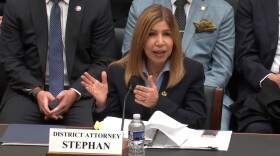The Pentagon is looking at sending ships on shorter, less predictable deployments. It’s a break with Navy tradition that sailors may welcome.
Secretary of Defense James Mattis is hinting publicly that he wants to get away from long deployments.
The USS Theodore Roosevelt just returned to San Diego from seven months at sea that included stops in the Middle East and western Pacific. These long tours, often planned out years in advance, are the way the U.S. Navy has operated basically since World War II.
Mattis told the House Armed Service Committee shorter, less predictable tours would allow the Navy to swarm a potential hot spot in crisis, rather than tour the globe for most of a year. He compared the Navy's current model to running on set routes to running a commercial shipping line.
Keeping ships in port, but making them available for quicker deployments, could lessen the strain on equipment, said Shawn VanDiver, a Navy veteran and now with the Truman National Security Project, an organization that advocates for national security solutions.
The idea of sailors being ready for a certain window, but not actually being at sea for the better part of the year could also be a hit with sailors, he said.
“I would have loved to have two months’ deployments. Go out for two months. Back in for two or three months. That would have been great. That would have been more time with my family. Six months in hard. Eight months is harder,” he said.
Tradition isn't the only thing standing in the way. Carrier groups are basically floating cities. Their movements demand careful planning. An aircraft carrier cannot just show up unannounced at port halfway around the world and expect to have services available, he said.
Readiness is also a major factor. Sailors need to be available for training. Shipyards need to prepare for scheduled overalls, he said.
“We need to be able to train and equip these ships, and if we don’t know where the ship is going to be in any given time in their training life cycle or geographically, how will we know when to send sailors to school,” he said.
The Navy hasn’t released a formal plan. Mattis has told lawmakers that he wants to make the Navy less predictable around the world.






